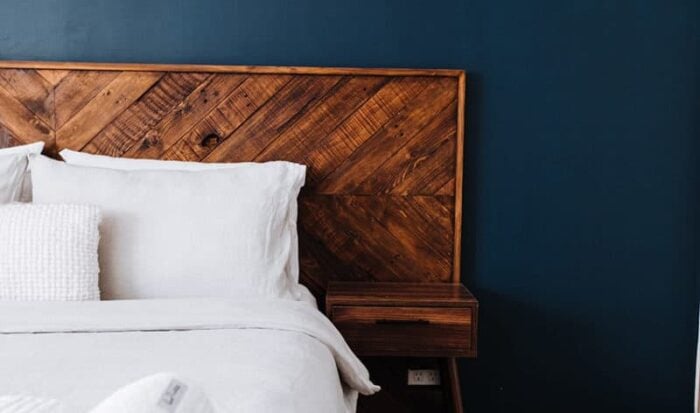Pillowcases come in all shapes and sizes, but have you ever used bed shams? These pillow coverings have been around since the 18th century. Today, they’re just as popular as they were hundreds of years ago.

But what is a sham and how does it differ from regular pillowcases?
For starters, it has a purely aesthetic role. Most homeowners use shams to create a unified theme for their bedroom or enhance its visual appeal. These bedding accessories can add a touch of style and personality to your home, bringing a splash of color to any room.
What Is a Sham?
Many people think of bed shams as small pillows with a variety of patterns and designs.
A sham is actually a decorative cover for pillows of different sizes.
Some are available in solid colors, while others feature intricate embellishments.
Generally, shams are made of satin, silk, and other premium fabrics, but you can also find cotton, linen, or polyester models. They come in standard pillow sizes and you can mix and match sizes when dressing your bed.
Think of a bed sham as a pillow casing with a facade. While you may use it as a normal pillow, its role is to enhance the appearance of your bedroom.
High-end retailers typically sell the covers, or shams, and pillows separately. However, you may use an inner filler of your choice.
DESIGNER TIP: When buying a pillow insert to use with a sham, remember to buy the insert that is 1-2″ larger than the overall size of the sham. A slightly oversized pillow will allow it to better fill out the sham and prevent it from looking saggy.
Generally, feather and poly-fill are best for pillow shams. The latter option is suitable for those who are allergic to feathers. The downside is that it tends to form lumps over time.
If you’re the crafty type, you can make your own pillow shams. All you need is some fabric and basic sewing supplies. But first, read on to find out more about the different types and sizes of bed shams and how to use them for maximum impact.
Pillow Shams vs. Pillowcases
For starters, make sure you understand the difference between a pillow sham and a pillowcase.
- First of all, pillowcases have a functional role. They are designed to protect the pillows you sleep on from dust, debris, bacteria, and bodily fluids. While some models have decorative details and embellishments, they’re generally simpler than a sham.
- Another difference between the two lies in their design. Most pillowcases are open at one end, while bed shams typically open from the back (their opening is often hidden).
- Pillow shams may also have flange edges on all four sides. This piece of fabric is often decorated with embroidery and embellishments.
- Regular pillowcases may have flanges, too, but they are more basic. Some styles only have a folded sewn hem.
- Bed shams are typically made from thicker fabrics that enhance their visual appeal. Pillowcases, on the other hand, are made from lighter, more breathable fabrics, such as cotton.
- Many consumers choose pillow shams that complement the color and design of their comforters, duvet covers, or quilts. Pillowcases are designed to complement the bedsheets.

While you may sleep on pillow shams, that’s not what they are meant for. These accessories have the role to add a decorative touch to your bedroom.
Pillowcases, by comparison, serve a functional purpose and have basic designs.
Both types of coverings are available in a large variety of colors and styles. Shams, however, have a distinctive design, with ruffles, flanges, monograms, embroidery, and other decorative details.
Types of Pillow Shams
If you ever go shopping for pillow shams, you may feel overwhelmed by the variety of styles and designs.
The two most popular options are standard shams and European pillow shams. These can be further broken down into several other categories based on their size, shape, and material.

European shams, or Euro shams, and standard shams look pretty similar. The primary difference between the two lies in their size.
A standard sham is 20″ by 26″ in size, points out Elle Decor.
European shams, on the other hand, are 26″ by 26″. Some European models measure 32″ in height and 32″ in width, but that’s less common. These big square pillows can be used in the same way as a standard sham.
You may also find quilted pillow shams, flanged pillow shams, and everything in between. These models are typically available in the sizes listed above. The difference between them lies in their design and/or the materials used.
Quilted pillow shams, for instance, are thicker and softer than other models. Some have decorative stitching on the front, while others are quilted on both sides.
Pillow Sham Sizes
Bedding stores may also offer queen shams, king shams, neckroll shams, and boudoir shams in addition to standard shams. Again, it’s their size that makes the difference.
Here’s a quick overview of the different sham sizes available on the market:
- Standard sham: 20″ x 26″
- Queen sham: 20″ x 30″
- Kind shams: 20″ x 36″
- Boudoir shams: 16″ x 12″
- Neckroll shams: 16″ x 6″ or 12″ x 6″ (and other sizes)
- Euro shams: 26″ x 26″
Except for Euro shams, all other models are rectangular. Some retailers also offer custom-sized shams.
If you’re wondering what size to choose, you may find these guidelines helpful:
- Standard shams go well with smaller bed pillows and make a good choice for twin beds. Depending on your preferences, you may use two or more standard shams to give your bed a fresh look.
- King shams and queen shams can complement a spacious bedroom with a queen or king-size bed. However, they are not as popular as other models because of their large size.
- Euro shams are suitable for most types of pillows and bed sizes and offer great support for reading or watching a movie while in bed.
- Boudoir shams and neckroll shams are usually placed in front of standard, queen, or king shams. Due to their small size, they have a purely decorative role.
Why Use a Pillow Sham?
Pillow shams can enhance the ambiance of your bedroom, allowing you to make subtle yet impactful changes.

For example, you may use rustic pillow shams to boost the appeal of a cottage bedroom. Floral pillow shams can add a splash of color to your bedroom, making it look cozier and more relaxing.
Minimalist pillow shams, on the other hand, are suitable for contemporary bedrooms.
When used properly, they can add a touch of style without making your bedroom look crowded. You could choose one color, such as white, for your bed sheets and abstract patterns or contrasting colors for your duvet cover and shams.
These accessories also protect your pillows from spills, dust, and pet hair, extending the time between washes. If you have a dog or cat, you can place shams on your sofa to minimize the risk of scratches.
Moreover, shams can breathe new life into your pillows. If you have an old pillow, you can turn it into a modern sham instead of throwing it away.
Pillow shams also offer a cost-effective way to upgrade your bedroom. It’s cheaper to redecorate with shams than repaint the walls or purchase fancy home decor items.
Worn-out pillow shams can be repurposed. You may turn them into a cozy pet blanket, a nice quilt, or a large placemat. There’s also the option to use them as floor pillows for kids or pets.
How to Care for Pillow Shams
As far as cleaning goes, shams are not too different from regular pillowcases. In general, they require less frequent washing since you don’t sleep on them.
Be sure to read the care label before laundering. Silk shams, for example, require more delicate care than flannel or cotton.

Experts recommend washing silk garments by hand or in the washing machine at 86 to 104 degrees Fahrenheit (30-40 degrees Celsius). Let them dry away from sunlight or direct heat.
Severely stained silk linens, including bed shams, should be dry-cleaned. Other delicate materials, such as satin and cashmere, require extra care, too.
Cashmere pillow shams, for instance, should be washed by hand with quality shampoo or wool/cashmere detergents.
If you’re going to use the washing machine, place each sham in a mesh laundry bag and run the delicate cycle on the lowest temperature setting. Do not use the dryer because it may shrink or damage the fabric.
Note that you should always remove the filler before washing a pillow sham. These items must be cleaned separately. Use mild detergents or natural cleaning solutions for shams to protect the fabric.
Creative Ways to Style a Bed with Pillow Shams
Pillow shams can be used in endless combinations to upgrade your bedroom.
For example, you can place mix and match shams of different sizes, colors, and textures for a playful ambiance. Or you can layer several shams to create an overflow of pillows.

These accessories are often stacked on the bed for a quick arrangement. You may also use one large pillow sham as a centerpiece.
Consider styling your bed with Euro shams for perfect symmetry. Another option is to use two shams in similar colors but with different patterns for a unique look.
There are no set rules for arranging your shams, so go ahead and play around with different colors, textures, and fabrics. You can even use different-sized pillow shams in an asymmetrical fashion.
Give Your Bedroom a Personal Touch
Now that we’ve answered your question—”What is a sham?”—it’s time for you to decide how you plan to use these accessories.
If, say, you want to give your bedroom a modern look, opt for pillow shams with abstract or geometric patterns.
Wool pillow shams, on the other hand, are ideal for rustic bedrooms. Silk shams can add a touch of luxury to your bedroom, while linen shams can help you create a relaxing, laid-back space.
What’s your favorite way to use pillow shams? Do you prefer a particular type of fabric or filling? Feel free to share your thoughts below.
Top Pick for Pillow Shams
- Standard Sham (microfiber)
- Euro Sham (waffle texture)
- Textured Sham (geometric pattern)
- Matching Sham Collections (microfiber)
FAQ
No, shams are usually decorative only and not meant to be slept on. But at the end of the day, a pillow is a pillow so use at your own discretion.
A sham on a bed is a decorative pillow that is usually put in front of other standard pillows. These tend to match the bedding and provide a pulled-together look for the whole bed.
Pillowcases are designed for you to sleep on. Shams are designed for aesthetics alone. This means that pillowcases are often made of thinner, more breathable fabric, and are easier to get on and off the pillow (for frequent washing). Shams are often made of a thicker fabric and either have a zipper closure or an overlapping opening in the back.
Citations
- Caring for Silk. Caring for Silk, Silk Association of Great Britain. (n.d.). Retrieved January 25, 2022, from http://www.silk.org.uk/caringforsilk.php
- Hepworth, A. (2020, September 24). How to wash cashmere by hand or in a machine (because yes, you can do that). PureWow. Retrieved January 25, 2022, from https://www.purewow.com/fashion/how-to-wash-cashmere
- Rubin, C. (2018, March 27). Ask Jennifer Adams: What purpose does a pillow sham serve. https://www.inquirer.com. Retrieved January 25, 2022, from https://www.inquirer.com/philly/living/pillow-sham-purpose-jennifer-adams-20180330.html
- Thomas, J. (2020, November 17). Styles of pillow shams. Home Guides | SF Gate. Retrieved January 25, 2022, from https://homeguides.sfgate.com/styles-pillow-shams-97828.html
- Tonelli Assistant Editor Lucia Tonelli is an Assistant Editor at Town & Country, L. (2021, November 1). If you’re unsure of what a sham is, this is the guide for you. ELLE Decor. Retrieved January 25, 2022, from https://www.elledecor.com/design-decorate/interior-designers/a24441546/what-is-a-sham/



